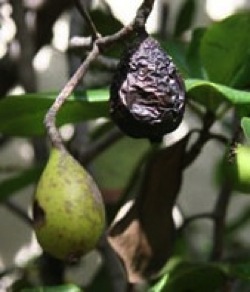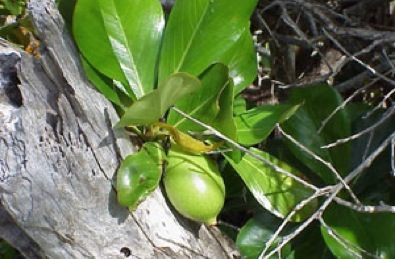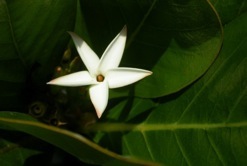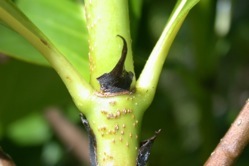Genipa clusiifolia: An Acquired Taste
Like a Suriname Cherry, you’ll either find the Seven Year Apple edible or disgusting. In fact, a lot of folks can’t get past the looks of the fruit.
The Genipa clusiifolia (JEN-ni-puh kloo-si-FOH-lee-uh ) fruit is edible only when black ripe, and then only the pulp, not the seeds. It’s actually a berry the size of a lime. You “eat” it by poking a hold in the tough rind and sucking out the pulp. (Again, don’t eat the seeds, they will make you throw up.) The flavor reminds some of prunes, others of liquorish. Many find it just plain awful.
While the great majority of the plants on this site are available throughout much of America, this is a South Florida, Caribbean native. Its Caribbean cousin, the Genipa americana, is used to make a common drink among the islands. (Nutritional information on G. americana below.)
Genipa is a latinized form of the Guyanian phrase nandi’pab meaning a “dark color on the chest.” It was used as a body dye among natives of South American. A metabolite in the pulp (iridiod genipin) turns black on contact with human protein and lasts for about three weeks. When used on fabric it’s a blue/purple dye. Juice from the green fruit has been used externally to treat syphilis. Clusiifolia relates to the resemblance of the leaves to the Clusia, a common tropical, subtropical shrub. For a century or so its name was Casasia clusiifolia (CASS-see-uh kloo-see-if-FOLE-ee-uh) and is still found under that name in many references. It honored a Captain General of Cuba, Louis de las Casas.
The common name, Seven Year Apple, is an exaggeration of how long the fruit takes to ripen, 10 months. The tree itself is in fruit year round. It’s the larval hose of the Tantalus Sphinx moth. As a tree, the wood is dark brown or reddish brown, closed grained, very heavy and hard. The bark is mostly smooth and gray. It provides cordage that can be used to make rough cloth. The wood, particularly of the G. americana, has been used for spears, rifle stocks, shoe lasts, frames for sieves, barrel hoops, ammunition chests, boxes, packing cases, plows, tool handles, flooring boards, door frames and cabinetwork.
The trees are in the Rubiaceae family and are closely related to the Gardenia; several Gardenia species were originally placed in Genipa genus. The metabolite genipin mentioned above is also obtained from the gardenia and is used in Chinese medicine to treat type 2 diabetes.
Evergreen, this shrub or small tree is one of Florida’s most exceptional native, salt-tolerant plants. It will grow right up to the first dune near the ocean. The leaves are glossy, leathery, and clustered near the branch tips. Flowers are clusters of white, pink-tipped blossom that show in spring and early summer. They have a very sweet, heavy fragrance. The fruits are green then yellow then spotted brown and finally black. While humans are divided on the taste of the Seven Year Apple mockingbirds love the emetic seeds and leave hollowed out black fruit skins hanging on the tree.
The fruit of the G. clusiifolia can be used like the fruit of the G. americana. In Puerto Rico, the G. ameriana is sliced up and put in a jar of water with sugar to make a drink like lemonade, occasionally it is allowed to ferment some. A concentrate is served with ice by street vendors. In the Philippines it is used to make jelly, sherbet and ice cream. The ripe pulp can be a substitute for commercial pectin. In rural Brazil they use it to make preserves, syrup, a soft drink, genipapada, wine, and a potent liqueur.
Food Value per 100 g of Edible Portion: Calories 113, Moisture 67.6 g, Protein 5.2 g, Lipids 0.3 g, Glycerides, 25.7 g, Fiber 9.4 g, Ash 1.2 g, Calcium 40.0 mg, Phosphorus, 58.0 mg, Iron 3.6 mg, Vitamin B 0.04 mg, Vitamin B2 0.04 mg, Niacin 0.50 mg, Ascorbic Acid 33.0 mg, Amino Acids (per g of nitrogen [N 6.25]) Lysine 316 mg, Methionine 178 mg, Threonine, 219 mg, Tryptophan 57 mg.
Green Deane’s “Itemized Profile”
IDENTIFICATION: Shrub or small tree to 10 feet, pale bark, leaves elliptical with edges recurved, two to six inches long, leathery, very glossy, clustered at the ends of branches. Flowers tubular, five white petals, an inch wide, often pink tipped and fragrant like jasmine. Fruit oval, two to three inches long, often dark spotted, then entirely black, jelly like pulp.
TIME OF YEAR: All Year
ENVIRONMENT: Can be found in the mainland, keys, coastal hammocks and sand dunes
METHOD OF PREPARATION: A hole is made in the fruit and the pulp sucked out. Do not eat the seeds. A drink can be made from the pulp. It can also be made into jelly and jam if you like the taste. The fruit is often used for fish bait.






Thank you for this article. I have a number of questions that I hope you won’t mind answering. Can Genipa Clusifolia be used for black body dye just as Genipa Americana is? Living in California, how could I obtain the unripened fruit to prepare the dye? Also, you mentioned that Gardenias have the same genipin metabolite as Genipa. Is there some way to use Gardenias as a source of blue black body dye? Again, thanks for this informative article.
The truth is, I don’t know.
I saw this plant on an episode of survivorman. He says it can be used as an antidote to a stone fish sting. Supposedly you chew a few new leaves up and apply it to the sting. I wonder if it really works… Ever heard of this?
No, never heard of it but I am not an herbalist.
We have a shrub about 8 ft. Tall, over 20 yrs. old, and looks like this shrub. The natives here in the Bahamas, call it a sabee abee tree,and they tell me, when they were kids they hollowed out the fruit and with a hollow twig from the almond tree they made a pipe. How can I find out if my tree is the casasia clusifolia tree? Thanks Jim Crandall
Youre so cool! I dont suppose Ive read anything this way prior to. So nice to seek out somebody by incorporating original thoughts on this subject. realy we appreciate you beginning this up. this fabulous website is one thing that is needed over the internet, someone after a little originality. useful problem for bringing something new towards the net!